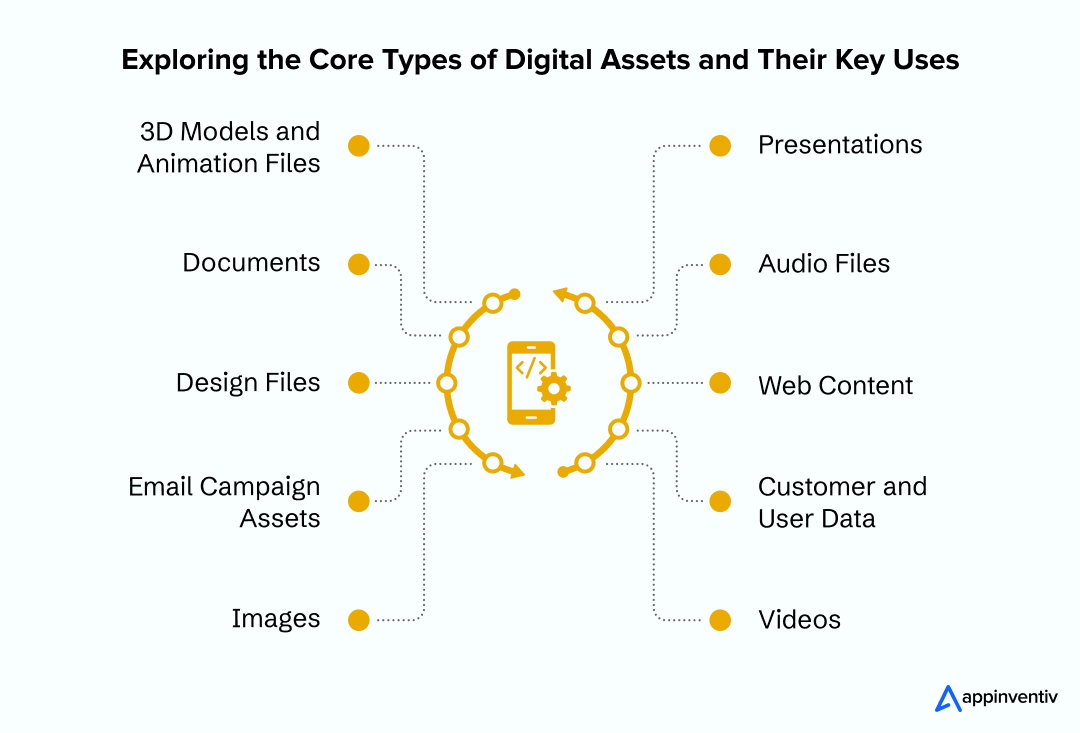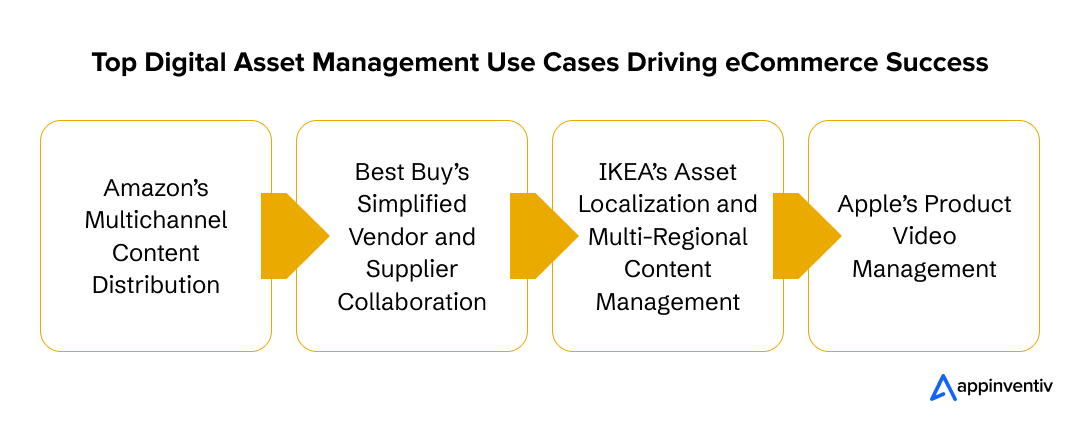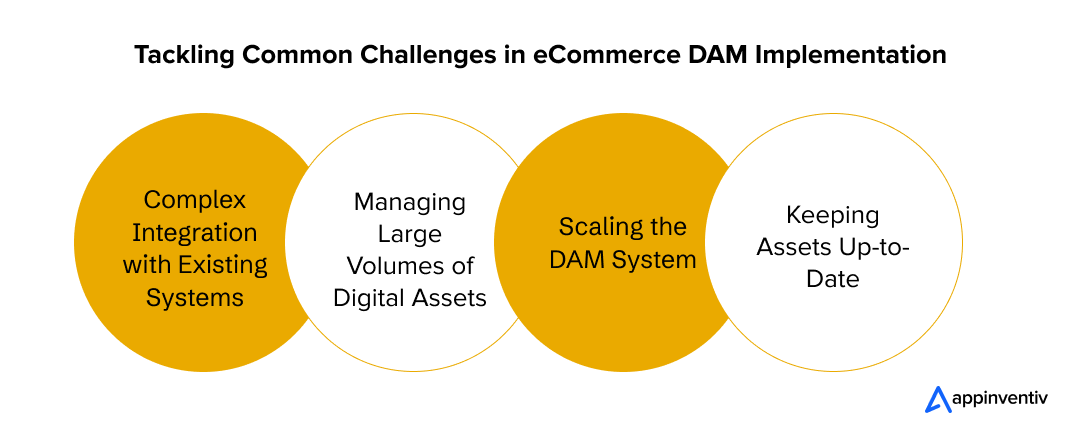- What is Digital Asset Management (DAM), and Why it’s Essential for eCommerce Success
- Core Types of Digital Assets and Their Uses
- 3D Models and Animation Files
- Documents
- Design Files
- Email Campaign Assets
- Images
- Presentations
- Audio Files
- Web Content
- Customer and User Data
- Videos
- Top 10 Benefits of Digital Asset Management in eCommerce
- 1. Faster Time to Market
- 2. Centralized Repository for Digital Assets
- 3. Enhanced Brand Consistency
- 4. Optimized Marketing Efforts
- 5. Better Collaboration and Scalability
- 6. Improved Compliance and Security
- 7. Improved Customer Experience
- 8. Analytics and Insights
- 9. Reduced Costs
- 10. Globalization and Localization
- Essential Features of eCommerce Digital Asset Management (DAM) Systems
- Key Digital Asset Management Use Cases in eCommerce
- Amazon’s Multichannel Content Distribution
- Best Buy’s Simplified Vendor and Supplier Collaboration
- IKEA’s Asset Localization and Multi-Regional Content Management
- Apple’s Product Video Management
- Challenges of Implementing Digital Asset Management in eCommerce With Solutions
- Complex Integration with Existing Systems
- Managing Large Volumes of Digital Assets
- Scaling the DAM System
- Keeping Assets Up-to-Date
- Trust Appinventiv for Your eCommerce Digital Asset Management
- FAQs
Running an eCommerce business without a central hub for your digital content invites chaos. With thousands of images, videos, and product descriptions constantly flowing through your channels, managing them effectively becomes a critical challenge. This is where Digital Asset Management (DAM) shines.
It’s not just about storage; it’s about giving your team instant access to the content they need when they need it and in the format that works best.
For eCommerce brands, DAM ensures that all digital assets are organized, optimized, and consistently aligned with your marketing strategies, creating a seamless customer experience. As eCommerce continues to evolve, those without a DAM solution risk falling behind, while those with one will stay ahead — delivering smarter, faster, and more personalized shopping experiences.
By leveraging the benefits of digital asset management in eCommerce, businesses can streamline workflows, improve content accessibility, and ensure consistent brand messaging across all touchpoints.
This blog will dive into how eCommerce DAM functions, its core types, key benefits, essential features, and real-world use cases. We’ll also explore the challenges businesses may face when implementing a DAM system. Let’s walk through these insights together!
What is Digital Asset Management (DAM), and Why it’s Essential for eCommerce Success
Digital Asset Management (DAM) is a powerful system designed to help eCommerce businesses organize, store, and manage digital content, including product images, videos, marketing collateral, and documents.
In the fast-paced world of eCommerce, where content is key to engaging customers and boosting sales, DAM ensures that digital assets are easily accessible, properly categorized, and ready for deployment across various platforms.
Centralizing all assets in one repository simplifies finding, updating, and sharing content across teams. DAM also integrates seamlessly with eCommerce platforms, enhancing workflows and maintaining consistency across product listings, campaigns, and advertisements.
With features like version control, SEO optimization, and advanced security, DAM eCommerce helps businesses keep their content fresh, high-quality, and protected. In a fiercely and highly competitive market, the benefits of digital asset management in eCommerce are numerous as it drives efficiency, improves collaboration, and enhances the customer experience, ultimately fueling business growth.
Core Types of Digital Assets and Their Uses
Digital assets refer to any content or media owned, managed, and distributed digitally. Understanding the various types of digital assets is essential for businesses to efficiently organize, manage, and utilize them to enhance marketing, branding, and content creation efforts. Let’s look at some of the top digital asset management system examples.

3D Models and Animation Files
3D models and animations create interactive experiences that allow customers to explore products virtually. These assets help customers visualize items in more detail, which is particularly valuable in industries like fashion or furniture, enhancing the shopping experience.
Documents
Product manuals, guides, and case studies offer valuable information to customers and prospects. They help build trust and credibility while providing details that support purchasing decisions, particularly for complex or high-ticket items.
Design Files
Design files, such as wireframes and source files, are the foundation of your eCommerce brand’s visual identity. They help you maintain consistency across all digital platforms, enabling quick updates to website designs, marketing materials, and promotional graphics.
Email Campaign Assets
Email campaign assets like templates, headers, and call-to-action buttons are crafted to drive customer engagement and conversions. These assets are essential for nurturing customer relationships, informing your audience, and encouraging repeat business.
Images
Images, from product photos to lifestyle shots, are key to communicating your brand and products visually. High-quality images build customer trust and make products more appealing, helping to drive engagement and sales.
Presentations
Presentations, whether pitch decks or webinars are used to share key business insights or product details with stakeholders. These assets allow you to present complex ideas clearly and engagingly, making it easier to connect with your audience.
Audio Files
Audio assets like podcasts, voiceovers, and background music add an auditory layer to your content. They are excellent for engaging audiences through storytelling, enhancing product videos, or providing a pleasant ad soundtrack.
Web Content
Web content, including blog posts, HTML, and CSS, helps your website rank easily on search engines and provides valuable information to your visitors. It plays a major role in driving organic traffic, improving SEO, and engaging customers across various touchpoints.
Customer and User Data
Customer and user data, including reviews, purchase history, and feedback, are crucial for personalizing marketing and improving products. This data helps businesses understand customer preferences, enabling more targeted campaigns and better product development.
Videos
Videos, including product demos, customer testimonials, and promotional clips, are powerful tools for connecting with your audience. They provide a more in-depth look at your products, build brand credibility, and can significantly increase conversion rates.
Top 10 Benefits of Digital Asset Management in eCommerce
Digital asset management for eCommerce helps businesses organize, store, and retrieve vast amounts of digital content efficiently, ensuring a smooth workflow across teams. Here are some of the top benefits of digital asset management in eCommerce:

1. Faster Time to Market
A DAM system significantly speeds up time-to-market by allowing teams to quickly access and reuse existing digital assets rather than starting from scratch. Whether it’s launching a new product or rolling out a marketing campaign, having everything organized reduces delays and improves efficiency. This helps businesses stay agile and respond quickly to new opportunities, seasonal trends, or urgent market demands.
2. Centralized Repository for Digital Assets
A DAM system stores all digital assets in one place, offering a streamlined approach to managing content. This centralized repository makes it easy to organize, search for, and retrieve assets quickly, saving valuable time and minimizing confusion. Whether it’s images, videos, or product information, teams can access what they need without wasting time digging through multiple folders or systems.
3. Enhanced Brand Consistency
One of the major benefits of digital asset management in eCommerce is enhanced brand consistency. Maintaining a regular and consistent brand image across all marketing channels is crucial, and digital asset management software for eCommerce helps ensure just that. Centralizing all brand assets, like logos, product photos, and promotional materials, guarantees that the latest and correct versions are always used. This minimizes errors and ensures a cohesive brand presence across your eCommerce site, social media, ads, and more.
4. Optimized Marketing Efforts
DAM systems make distributing content across various channels easy, ensuring a consistent message and branding everywhere it appears. With the ability to track asset performance, marketers can also measure how different pieces of content are performing. This data helps fine-tune future campaigns and provides insight into an array of content that resonates best with the audience, making marketing efforts more effective.
5. Better Collaboration and Scalability
As businesses grow, so does the volume of content they need to manage. A DAM system makes collaboration between teams smoother by offering a single platform for updating assets. This shared system ensures that everyone is on the same page and helps businesses scale without the risk of losing control over the increasing number of digital assets they generate. It also supports efficient cross-departmental workflows, making projects move faster.
6. Improved Compliance and Security
A DAM system ensures that your assets comply with legal and copyright regulations. It helps you manage licensing, permissions, and usage rights to ensure that assets are used appropriately. Additionally, DAM eCommerce platforms often have built-in security features, like user access controls, to ensure that authorized personnel only access sensitive content, reducing the risk of data breaches or misuse.
7. Improved Customer Experience
Digital assets like high-quality images, product videos, and detailed descriptions are key to a great eCommerce experience. DAM ensures that customers always see the most up-to-date and engaging content. This makes the shopping experience more enjoyable and helps increase conversion rates by presenting products in the best light possible. Personalized content can be tailored to customer preferences for even better engagement.
8. Analytics and Insights
DAM systems often include data analytics tools offering valuable insights into asset performance. By tracking metrics like views, engagement, or conversion rates, businesses can see what works and what doesn’t. This data-driven approach allows marketing teams to make informed decisions, tweak strategies, and optimize content to improve performance and meet customer needs.
9. Reduced Costs
Reduced cost is again one of the vital benefits of digital asset management in eCommerce. Using a DAM system can lead to significant cost savings over time. By centralizing digital assets, businesses can avoid creating redundant content by reusing assets across multiple campaigns or product listings. This helps reduce production costs while also lowering storage expenses by consolidating files in one system rather than managing them across various platforms or servers.
10. Globalization and Localization
For eCommerce businesses with international reach, DAM systems make managing content across regions or languages much easier. Whether translating product descriptions or adapting marketing materials for local audiences, DAM enables businesses to store and distribute localized content seamlessly. It also helps ensure regional laws and regulations compliance, making global expansion more efficient and manageable.
Essential Features of eCommerce Digital Asset Management (DAM) Systems
A robust DAM system for eCommerce offers essential features that support proper organization, access, and distribution of digital content, ensuring a smooth and efficient workflow. Let’s check out the key features of an eCommerce DAM solution.

Seamless Collaboration and Sharing: With customizable permission settings, users can seamlessly control who can view, edit, or share assets, ensuring collaboration remains organized and secure.
Advanced Search and Metadata Management: The right asset is crucial for efficient workflows. DAM systems offer powerful search functionalities, allowing users to filter assets by tags, keywords, categories, and metadata.
Version Control and Asset History: Version control also allows businesses to review the history of each asset, including any changes made and who made them, reducing the risk of using outdated or incorrect content.
Centralized Storage for Digital Content: Whether it’s images, videos, documents, or audio files, storing all assets in a single repository ensures teams can easily find and manage content without navigating multiple platforms or devices.
Cloud Storage and Scalability: With cloud storage, assets are securely stored and easily accessible from anywhere, ensuring a seamless workflow for teams across different locations without worrying about physical hardware.
Brand Consistency Management: DAM systems help businesses store and organize all brand assets (logos, color schemes, fonts, etc.) in one place, ensuring that teams always use the most up-to-date materials and maintain brand integrity.
Access Control and User Permissions: With customizable access controls, businesses can restrict asset access based on roles, ensuring that sensitive content is only available to authorized personnel.
AI and Automation for Content Tagging: Some DAM platforms integrate artificial intelligence (AI) to automate content tagging, improving asset organization. For example, AI in asset management can recognize objects or text in images, automatically adding relevant tags and metadata to simplify searching and categorizing.
Multilingual and Localization Support: DAM platforms offer multilingual support and localization tools for companies operating in multiple regions. This ensures that digital assets are customized and appropriately localized for different markets, making it easier to manage content globally while maintaining consistency.
Automated Workflow and Approval Processes: Automated workflows route assets for review and approval, reducing bottlenecks and speeding up the time to market for new content.
Rights Management and Licensing Tracking: DAM platforms offer rights management tools that help track asset usage rights, ensuring that businesses comply with licensing agreements and avoid legal issues related to asset use.
Support for Multiple File Formats: A comprehensive DAM eCommerce system supports a wide variety of file formats, including images (JPEG, PNG, TIFF), videos (MP4, MOV), audio files (MP3, WAV), and documents (PDF, DOCX, etc.). Some platforms also include built-in tools for converting files into different formats to make them suitable for various uses, such as resizing images or adjusting video resolution.
Key Digital Asset Management Use Cases in eCommerce
From managing large volumes of multimedia content to ensuring consistent branding across channels, DAM systems enable businesses to streamline operations, elevate the customer experience, and boost sales. Here are some of the key digital asset management use cases in eCommerce:

Amazon’s Multichannel Content Distribution
Modern eCommerce businesses must deliver content across various platforms and channels, including websites, social media, email campaigns, and third-party marketplaces.
One of eCommerce’s key digital asset management benefits is that it enables companies to organize and distribute assets in different formats (such as optimized images, videos, and banners) tailored to each platform, making content delivery faster and more efficient.
Amazon, for instance, utilizes its DAM system to manage and distribute content across its extensive global platform. With millions of products and variations, Amazon stores images, videos, product descriptions, and other digital assets in one centralized location.
This allows Amazon to quickly optimize and deploy content to different regions and platforms, including its main website, mobile apps, and international marketplaces, ensuring consistency and speed in content delivery.
Best Buy’s Simplified Vendor and Supplier Collaboration
eCommerce businesses often work with suppliers, manufacturers, or third-party content creators. One of the most crucial benefits of digital asset management in eCommerce is that the DAM system can streamline this collaboration by providing a secure, centralized platform where assets like product images, videos, and marketing materials can be easily shared. This reduces the back-and-forth typically involved in the process, helping to speed up workflows and improve efficiency.
Best Buy, a leading electronics retailer, uses a DAM system to manage digital assets from various suppliers and vendors. By centralizing product-related content in one location, Best Buy ensures that images, specifications, and promotional materials are readily accessible to its teams, reducing errors and accelerating the online listing of new products.
IKEA’s Asset Localization and Multi-Regional Content Management
IKEA leverages its DAM system to manage an extensive digital content library, from product photos and promotional images to videos and catalogs. With a presence in 50+ countries, IKEA uses its DAM to efficiently localize content for various markets while preserving a unified global brand message.
IKEA’s DAM system streamlines localizing and distributing content across digital and print channels, ensuring each market receives tailored content that resonates with local preferences. This approach speeds up the deployment of marketing materials and enhances brand consistency worldwide, ensuring that regional and global marketing efforts align seamlessly.
Our experts at Appinventiv developed an ERP solution for IKEA that enhances asset management by allowing customers to browse the store’s product catalog on tablet panels while leveraging their data for personalized promotions.

This innovative system has been successfully deployed across 7+ IKEA stores in the UAE and is now recognized as a key driver of ROI measurement for the retailer. Our solution has transformed the in-store experience, optimizing inventory management and customer engagement.
Apple’s Product Video Management
Product videos are increasingly vital in eCommerce, offering customers in-depth views and demonstrations of products. A DAM system helps organize, optimize, and manage these videos, ensuring they are easily accessible on product pages, in marketing campaigns, and across social media platforms.
Apple utilizes the DAM system to manage its vast collection of product videos, promotional content, and tutorials. These assets are stored, categorized, and made available through the DAM platform, enabling teams worldwide to quickly access and use the latest videos for product launches, website updates, or social media campaigns.
Challenges of Implementing Digital Asset Management in eCommerce With Solutions
Implementing DAM in eCommerce can be complex, with various obstacles along the way. However, with the right approach and tools, businesses can effectively navigate these challenges and unlock the full potential of their DAM systems. Let’s have a detailed look at those.

Complex Integration with Existing Systems
Integrating a DAM system with eCommerce platforms, CRMs, and other business tools can be complicated, leading to delays and disruptions in daily operations.
Solution: Develop a DAM system with open APIs and ensure it is compatible with your current software. Working with integration specialists or consulting firms like Appinventiv can streamline the process, reducing potential integration headaches.
Managing Large Volumes of Digital Assets
As your business scales, managing an increasing number of digital assets (images, videos, documents, etc.) can become overwhelming, leading to disorganization and inefficiency.
Solution: Leverage AI-based tools within the DAM system to automate asset categorization, tagging, and organization. This automation significantly reduces the manual effort required and ensures assets are properly organized at scale.
Scaling the DAM System
As your business grows, the DAM system must be able to scale to handle more assets and more complex workflows without affecting performance. Poor scalability can lead to slowdowns or system crashes.
Solution: Opt for a cloud-based DAM system with flexible storage and scalability. This will enable you to expand as your digital asset needs grow without major disruptions. Cloud-based systems also provide the advantages of remote access and easier collaboration.
Keeping Assets Up-to-Date
Outdated or irrelevant assets can create confusion, lead to inconsistencies across marketing channels, and negatively affect customer experience. Keeping assets updated across different regions or platforms is a constant challenge.
Solution: Set up automated workflows for asset reviews and updates, ensuring that outdated content is flagged for revision and replaced with current materials. Establishing a regular audit schedule ensures that assets stay relevant and accurate.
Trust Appinventiv for Your eCommerce Digital Asset Management
As eCommerce continues to evolve, the demand for more efficient and streamlined eCommerce digital asset management solutions is growing rapidly. With the explosion of multimedia content, from high-quality images and videos to interactive experiences, eCommerce businesses face the challenge of managing vast digital assets.
Advancements in AI, machine learning, cloud, and other areas will define the future of eCommerce DAM, enabling smarter asset organization, automated tagging, and enhanced search capabilities.
By leveraging the latest technologies, Appinventiv helps businesses streamline the management and delivery of digital assets, ensuring a seamless and efficient workflow. The custom-built DAM solutions enable eCommerce businesses to stay agile, maintain brand consistency, and boost operational efficiency.
Hiring Appinventiv for eCommerce app development services can help businesses future-proof their asset management systems, enhance collaboration across teams, and ultimately help them leverage all the benefits of digital asset management in eCommerce.
For companies looking to stay competitive and scale efficiently in the digital age, Appinventiv is the trusted partner for all their DAM needs.
Connect with our experts today to get started.
FAQs
Q. What is DAM in eCommerce?
A. Digital Asset Management (DAM) in eCommerce refers to the system and processes that organize, store, and manage digital content, such as images, videos, product details, and marketing materials. A DAM solution helps eCommerce businesses streamline the management of their digital assets, ensuring they are easily accessible, properly organized, and optimized for use across various sales and marketing channels.
Q. What are the benefits of AI in digital asset management in eCommerce?
A. Here are some of the top benefits of digital asset management in eCommerce when integrated with advanced technologies like AI:
- Automates tagging and categorization of assets
- Generates accurate metadata for better searchability
- Reduces manual labor in asset management
- Optimizes content for different platforms
- Improves asset performance across channels
- Speeds up decision-making for marketing and product teams
- Enhances content discoverability through AI-driven analysis
Q. How do you implement a digital asset management system in eCommerce?
A. To implement a digital asset management system for eCommerce, follow these steps:
Evaluate Your Needs: Identify your business’s requirements, such as the types of digital assets you manage, the number of users, and your content workflows.
Build DAM Solution: Build a DAM system for eCommerce that meets your needs, focusing on scalability, ease of integration, and user-friendliness.
Integrate with Existing Tools: Ensure the DAM system integrates well with your eCommerce platform, CRM, marketing software, and other tools.
Organize Your Assets: Create a clear system for categorizing and tagging assets to ensure easy access and efficient management.
Train Your Team: Train employees on how to use the DAM system effectively.
Continuous Improvement: Regularly review and refine the system to accommodate the growing needs of your business.



A Comprehensive Guide to Healthcare eCommerce
Imagine this: a working mother notices her child has a persistent cough. Instead of rearranging her schedule to visit a clinic, she books a teleconsultation with a pediatrician, gets a prescription instantly, and orders the medicine online - all within an hour. Meanwhile, a rural patient needing advanced medical equipment can browse through an ecommerce…

Imagine walking into a traditional car dealership, greeted by a salesperson who asks you a few questions about what you're looking for. You might browse through rows of vehicles, each with different features, colors, and prices. The process feels long, often overwhelming, and at times, you may leave feeling uncertain about the best choice. Now…

How Much Does It Cost to Build an eCommerce App Like Jarir Bookstore?
Do you know what propels an eCommerce app from just functional to phenomenally successful? Well, the answer is the buzz it creates. This compelling mix of word-of-mouth enthusiasm that users share with friends, colleagues, and family. When customers are impressed enough to recommend your app, that's not just a win but a revenue multiplier. Now,…











